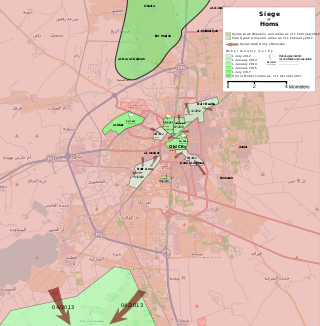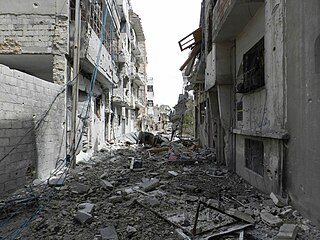On Friday 6 May 2011, during the 2011 Syrian uprising or civil war, Syrian government armed forces with tanks and troops started an attack on and occupation of Homs, Syria's third largest city [1] with 650,000 inhabitants. Until 12 May they reportedly killed 37 residents and cut off water and medical care, held house-to-house raids to arrest hundreds of residents and shelled the town. On 13, 20, 21, 27 and 29 May, again 21 protesters reportedly were killed by security forces. At least 13 soldiers or policemen were killed in May by terrorist groups, the government reported.
15 and 16 March 2011, demonstrations for democracy took place in six cities across Syria, the largest protest was in Daraa. This started a series of ever larger and angrier demonstrations all around Syria through March and April, with security forces firing on demonstrators resulting in hundreds of deaths. The protests spread, among other places, to Homs on Friday 18 March, after online calls for a "Friday of Dignity" (Arabic : جمعة الكرامة). 2,000 protesters then took to the streets in Homs after Friday prayers.
As protests in Syria continued, Homs became one of the most restive cities in Syria, with more protests on 25 and 29 March and 95 civilian deaths during protests on 1, 8, 17–19, 22 and 29 April 2011. On 25 April, the Syrian government had intensified its crackdown on the protests with an organised military attack on the city of Daraa, on 26 April on Douma.
On 6 May 2011, Homs became, after Daraa on 25 April, the second centre of the Syrian protests and uprising to be confronted with a large scale, organised, deadly attack by the Syrian military.
This May 2011 operation did not quell protests in Homs, nor subdue the city: October–November 2011, rebels in Homs’ Baba Amr neighbourhood ambushed government's security forces. More uprising and warlike events occurred until May 2014 in Homs, after July 2012 all unmistakably events of the Syrian Civil War that by then undisputedly was taking place in Syria.
The following is a timeline of the Syrian Civil War from May to August 2011, including the escalation of violence in many Syrian cities.
The siege of Rastan and Talbiseh was an operation by the Syrian Army during the Syrian revolution. On 28 May 2011, after protests and an armed revolt, the Syrian Army launched an operation in al-Rastan, a city of an estimated 50,000 residents located 20 kilometers north of Homs, and the neighboring town of Talbiseh, which resulted in the suppression of the protests and numerous deaths. The Syrian Army met some armed opposition during the siege.

The 2011 siege of Hama was among the many nationwide crackdowns by the Syrian government during the Syrian revolution, the early stage of the Syrian civil war. Anti-government protests had been ongoing in the Syrian city of Hama since 15 March 2011, when large protests were first reported in the city, similar to the protests elsewhere in Syria. The events beginning in July 2011 were described by anti-government activists in the city as a "siege" or "blockade".
On 13 August 2011, during the early insurgency phase of the Syrian civil war, the Syrian Army and Syrian Navy launched an operation in the Syrian coastal city of Latakia in order to end an anti-Assad rebellion in the Palestinian camp. The operation resulted in dozens of people killed and wounded. Latakia has remained relatively quiet throughout the Syrian civil war subsequent to the operation.
Protests began in Syria as early as 26 January 2011, and erupted on 15 March 2011 with a "Day of Rage" protest generally considered to mark the start of a nationwide uprising. The Syrian government's reaction to the protests became violent on 16 March, and deadly on 18 March, when four unarmed protesters were killed in Daraa.
The following is a timeline of the Syrian uprising from September to December 2011. This period saw the uprising take on many of the characteristics of a civil war, according to several outside observers, including the United Nations Commission on Human Rights, as armed elements became better organized and began carrying out successful attacks in retaliation for the ongoing crackdown by the Syrian government on demonstrators and defectors.

The siege of Homs was a military confrontation between the Syrian military and the Syrian opposition in the city of Homs, a major rebel stronghold during the Syrian Civil War. The siege lasted three years from May 2011 to May 2014, and ultimately resulted in an opposition withdrawal from the city.

The 2011–2013 Daraa Governorate clashes are a series of military confrontations between the Syrian Army and the Free Syrian Army in Daraa Governorate, Syria, which began in November 2011, after widescale protests and crackdown on protesters in Daraa had lasted since April 2011. The clashes had been ongoing as part of the Syrian civil war, until the U.N. brokered cease fire came into effect on 14 April 2012. Sporadic clashes continued since then, however.
The Rif Dimashq clashes were a series of unrests and armed clashes in and around Damascus, the capital of Syria, from November 2011 until a stalemate in March 2012. The violence was part of the wider early insurgency phase of the Syrian civil war. Large pro-government and anti-government protests took place in the suburbs and center of Damascus, with the situation escalating when members of the Free Syrian Army (FSA) started attacking military targets in November.

The 2012 Aleppo Governorate clashes were a series of battles as part of the early insurgency phase of the Syrian civil war in the Aleppo Governorate of Syria.

The September 2011 – March 2012 Idlib Governorate clashes were the violent incidents that took place in Idlib Governorate, a province of Syria, from September 2011 and prior to the April 2012 Idlib Governorate Operation.
The following is a timeline of the Syrian Civil War from January to April 2012, during which time the spate of protests that began in January 2011 lasted into another calendar year. An Arab League monitoring mission ended in failure as Syrian troops and anti-government militants continued to do battle across the country and the Syrian government prevented foreign observers from touring active battlefields, including besieged opposition strongholds. A United Nations-backed ceasefire brokered by special envoy Kofi Annan met a similar fate, with unarmed UN peacekeepers' movements tightly controlled by the government and fighting.
The Battle of Zabadani took place in January through February 2012, during the Syrian civil war. During the initial stages of the battle, the rebel FSA took control of the town. However, less than a month later, the Army retook control of Zabadani, forcing rebel fighters to withdraw towards the Lebanese border.

A second battle between the Syrian Army and the Free Syrian Army for control of the city of Rastan took place from 29 January to 5 February 2012. Located in Homs Governorate, Rastan is a city of 60,000 residents. The FSA captured Rastan after days of intense fighting, according to residents and the opposition.

The 2012 Homs offensive was a Syrian Army offensive on the armed rebellion stronghold of Homs, within the scope of the Siege of Homs, beginning in early February 2012 and ending with the U.N. brokered cease fire on 14 April 2012.

The first of the two battles in al-Qusayr was fought by the Syrian army and Shabiha against the Free Syrian Army in the small city of Al-Qusayr, near Homs, during late winter and spring of 2012.
The Hama Governorate clashes were a series of incidents of fighting during late 2011 and early 2012 in the Syrian Governorate of Hama, as part of the Early insurgency phase of the Syrian Civil War.
The following is a timeline of the Syrian Civil War from May to August 2012. The majority of death tolls reported for each day comes from the Local Coordination Committees, an opposition activist group based in Syria, and the Syrian Observatory for Human Rights, another opposition group based in London.
The siege of Daraa occurred within the context of the 2011 Arab Spring protests in Syria, in which Daraa was the center of unrest. On 25 April 2011, the Syrian Army began a ten-day siege of the city, an operation that helped escalate the uprising into an armed rebellion and subsequent civil war.

The Syrian revolution, also known as the Syrian Revolution of Dignity, was a series of mass protests and uprisings in Syria – with a subsequent violent reaction by the Syrian Arab Republic – lasting from March 2011 to June 2012, as part of the wider Arab Spring in the Arab world. The revolution, which demanded the end of the decades-long Assad family rule, began as minor demonstrations during January 2011 and transformed into large nation-wide protests in March. The uprising was marked by mass protests against the Ba'athist dictatorship of president Bashar al-Assad meeting police and military violence, massive arrests and a brutal crackdown, resulting in thousands of deaths and tens of thousands wounded.